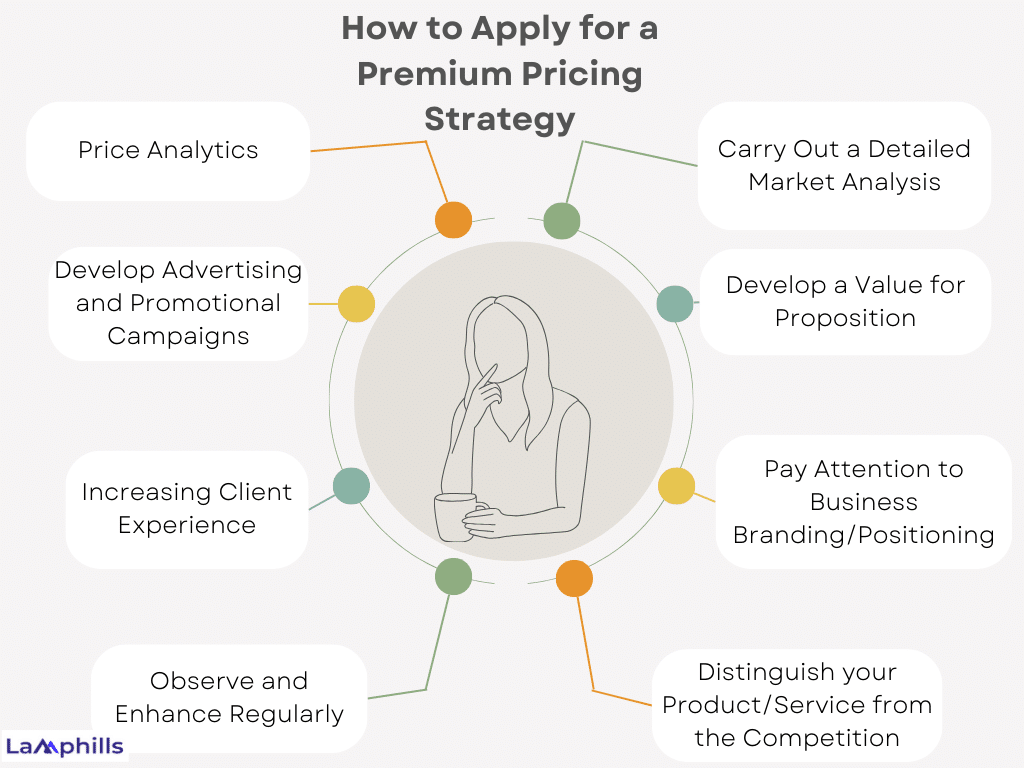In the market space where different businesses and startups are continuously being established, every brand needs to set up its roots in any segment to sustain itself. The premium pricing plan is the greatest among all the segments because it improves your brand’s perception and increases revenue for your business. You may use this premium pricing strategy by positioning your brand as a high-end or premium authority in the market and charging more for high-value services or experiences. This strategy is not only about charging higher prices, but it has several other essential factors before implementing it. Of course, premium pricing is not without its challenges. It is a strict pricing approach that isn’t suitable for all SaaS companies.
But for those that can make it work, the benefits to the market are huge, and your product’s perceived quality will improve, not to mention the enormous profit margins. I’ll address every important aspect in this post, from “What is premium pricing strategy” to “How you can implement it,” and I’ll end by giving you some examples of premium pricing strategies used by various brands. You can continue reading to gain more insight.
Key Takeaways
- A premium pricing strategy positions a brand as a high-end authority, enhancing perception and revenue by charging higher prices for high-value services or experiences. This strategy leverages brand quality, customer service, and perceived value, differentiating it from merely overpriced products.
- Successful implementation requires a strong customer base, brand loyalty, and word-of-mouth marketing to ensure customers perceive the value and exclusivity of the product.
- Applying premium pricing involves conducting market analysis to understand customer willingness to pay, developing a value proposition with unique features, and strong branding, distinguishing products from competitors, analyzing costs and pricing sensitivity, and creating effective marketing campaigns.
What is a Premium Pricing Strategy
Premium pricing strategy, often known as prestige pricing is a pricing approach where a company sets a higher price for its products or services compared to its competitors. This strategy is based on the idea that the product or service offers unique benefits, quality, or prestige that justifies the higher price. The goal? To create an image of exclusivity and superior quality. But let’s not confuse high prices with overpriced. Premium pricing is about perception, not just the numbers. As a specialist, I’ve witnessed how premium pricing can be a game-changer for businesses.
Businesses that have a strong brand, high-quality features, friendly customer service, and good value for the money typically have a successful premium pricing strategy. Businesses that use a premium pricing approach establish their unique brand in the marketplace. It facilitates the increase of industry profit margins for them. In this instance, the premium pricing is competitive with marketing strategies. Marketing professionals use tactics to persuade customers that a well-known brand values respect and that the company producing it produces goods of superior quality. In essence, premium pricing cultivates the perception that a company is dominant in the market and that its value and quality are commensurate with its price.
Price skimming is correlated with premium pricing. Nonetheless, premium pricing entails setting higher costs and maintaining them there for an extended time, as opposed to price skimming. Luxury brands are generally linked to premium pricing.
Examples of Premium Pricing
Example #1
Apple’s iPhone is a fantastic example of a premium price. Because of its sleek design, intuitive UI, and high-quality camera, the iPhone is seen as a premium product even if it costs more than other cell phones on the market. I remember when I bought my first iPhone. The decision wasn’t about the features alone. It was the allure of owning something perceived as the best. It made me feel part of an elite group. That’s the magic of premium pricing – it taps into our emotions and desire for exclusivity.
Example #2
Another example would be luxury car brands like Tesla, BMW, and Mercedes-Benz, which are more expensive because of their reputation for performance and quality. They don’t just sell cars; they sell innovation, performance, and a vision for the future. Tesla, for instance, isn’t just about electric vehicles. It’s about revolutionizing transportation. This narrative makes customers feel like they’re part of something bigger.
Benefits of Using Premium Pricing Strategy
The premium pricing model has specific benefits and drawbacks. As with any pricing tactics used to increase prices, the procedure is accompanied by a rigorous approach. However, before discussing further, the following benefits of premium pricing should be looked at:

- Increased earnings: Premium pricing will naturally result in higher profit margins for your company, if successful. It’s basic math, a higher price-per-unit leads to higher profit-per-unit sold.
- Enhanced brand value: Premium pricing improves the perception of the business. If a company properly positions its items as high-quality and valuable, there’s a very good possibility that customers will think highly of the business and stick with the brand.
- Increasing the entrance barrier: It would be more difficult for new competitors to enter the market and compete with an established company that charges premium prices if that company enjoys strong brand awareness and customer loyalty. It is feasible to establish dominance based on quality and value and quickly acquire market advantage by using a premium pricing strategy.
- Competitors advantage: A corporation gains a competitive edge when it can raise prices. In essence, a company that uses premium pricing gains more earnings, brand recognition, and devoted customers. It is possible to turn each of these components into a competitive advantage.
How to Apply for a Premium Pricing Strategy

#1. Carry Out a Detailed Market Analysis
Before anything else, you need to study your target market, audience, and competitors in the business. Finding out whether your target market is interested in premium goods and is willing to pay a higher price would be beneficial.
#2. Develop a Value for Proposition
Assume that your clientele is prepared to shell out more for unique goods or services. Then, you have to add premium features and unique experiences to your goods or services to make them appealing. It presents your product as having exceptional value.
#3. Pay Attention to Business Branding Or Positioning
To execute the premium pricing plan, you need to establish a solid company brand. You must create original marketing messaging, design your materials and packaging, and make your brand perceived as a premium product.
#4. Distinguish your Product/Service from the Competition
Like Apple, you must positively set yourself out from your competition to get your goods and services into the premium market. To put it plainly, you need to provide your customers with superior features, higher-quality products, amiable and supportive customer service, and an overall premium experience. It will support your premium pricing in a highly cutthroat industry.
#5. Price Analytics

Now, do a detailed analysis of your costs, your brand’s impression among customers, and your competitors. Remember to consider your clients’ profit margins, product value, pricing sensitivity, and production costs as well. Next, determine how much to charge for your goods and services.
#6. Develop Advertising and Promotional Campaigns
To highlight your brand’s premium product, it would be beneficial if you developed some successful marketing and promotional techniques. Utilize marketing strategies such as content marketing, social media marketing, and advertising. It will assist you in positioning your brand image in the premium market and raising brand recognition.
#7. Increasing Client Experience
Offering your clients a premium feel or experience through your brand is crucial if you want to charge premium prices. You may achieve this by offering your customers exceptional customer care, personalized attention, high-quality packaging, and eye-catching presentation while delivering your goods or services.
#8. Observe and Enhance Regularly
Finally, your target market, customer feedback on your products, and sales results need to be continuously monitored. To keep your product competitive and relevant in your market, you need to make all the necessary improvements.
Free Download Checklist on How to Apply for a Premium Pricing Strategy
Drawbacks of Using Premium Pricing Strategy
Every strategy has its share of difficulties. Premium pricing needs ongoing quality maintenance and may turn off some potential clients. So, what are the disadvantages of premium pricing?
- High development cost: Price elasticity and demand function directly affect premium pricing. Essentially, let’s say a business charges a high price but lacks a distinctive selling proposition. It might have to pay a greater distribution cost that isn’t offset by the strategy’s gains.
- Reduces market opportunity: Selling your goods to a mass market is made more difficult by premium price. Although SaaS companies are less affected by this than, say, fashion brands, you are still willingly giving up some of your market share.
- Potential backfire: There are times when premium pricing can backfire when a business is put in a market with plenty of competitors. Consider the following scenario: a company decides to charge more for a high-quality product. There’s a risk that some rivals will provide comparable goods at a reduced cost. That’s when premium pricing is going to backfire.
- Diminish price competition: Setting your price higher than your competitors exposes you to their undercutting strategies, especially if your industry is crowded. If a rival appears and offers a comparable good or service at a lower cost, your premium price may backfire.
Unarguably, I’ve encountered such challenges in my business. To resolve any issues. I put a lot of emphasis on excellent customer service and transparent communication to lessen them. With that being done, I ensure that customers are aware of the value they are receiving quickly.
What Brands Use Premium Pricing Strategy?
Many brands use premium pricing as part of their wider strategy. Some notable examples include:
- Fashion brands like Gucci and Louis Vuitton
- Premium beauty brands like SK-II and La Mer
- Luxury watch brands like Rolex and Patek Philippe
- High-end electronics brands like Bang & Olufsen
When Brands Use Premium Pricing
To optimize the benefits of premium pricing, a brand must meet some prerequisites before putting the strategy into practice. Before cutting your pricing to the premium market, you should have a solid customer base and strong brand loyalty. At the beginning of a premium trip, it would always enable you to have an assurance of certain devoted customers to at least reach your break-even point.
Additionally, strong word-of-mouth marketing for your product is generated by brand loyalty. In this instance, the degree to which your customers are persuaded that other customers are prepared to pay that premium will determine how willing they are to pay. This is referred to as increasing your product’s brand equity.
Conclusion
In summary, premium pricing entails more than just charging a premium; it also entails establishing exclusivity, value, and a strong emotional bond with your customers. You can successfully implement and maintain a premium pricing strategy, by carefully crafting your narrative, ensuring exceptional quality, leveraging exclusivity, and continuously innovating. This strategy can be a highly effective way to differentiate your business and increase revenue. Businesses can decide on their pricing approach with knowledge of the benefits and drawbacks of premium pricing.
So how do you increase the value of your brand and differentiate yourself in a competitive market? Ready to seize the advantages of premium pricing? Although the road may be difficult, the benefits such as increased profits, a distinguished market position, and brand loyalty are well worth it.
Related Articles
- Business Wire Pricing: 2024 Cost Breakdown & All You Need
- 15+ Public Relations Tools That Work: A Personal Guide to Enhancing Your PR Strategy
- Pillars of Omnichannel Management
- 7 Strategies for Utilizing Brand Influencer Opportunities in 2024






